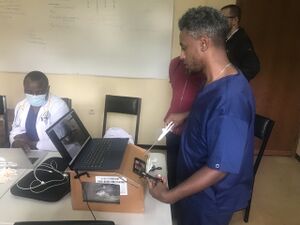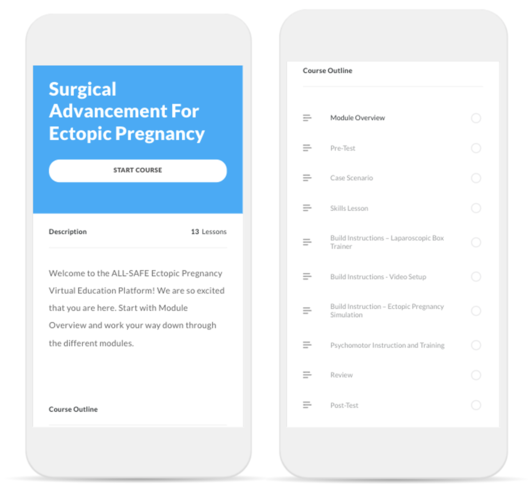
*** Caution this is not the most updated version of this page. Please see our final version here: ALL SAFE Syllabus.[edit | edit source]
Welcome to the ALL-SAFE Appropedia page.[edit | edit source]
ALL-SAFE, African Laparoscopic Learners for Safe Advancement For Ectopic Pregnancy, is an initiative with the goal of training surgeons with the necessary skills and confidence to perform laparoscopic treatment of ectopic pregnancy in resource-constrained settings.
Our team has designed a knowledge and skills-based training platform for participants. Everything is housed in one website platform.
This study is in collaboration with the Pan-African Academy of Christian Surgeons (PAACS), the College of Surgeons in East, Central, and Southern Africa (COSECSA), the University of Michigan, Southern Illinois University, Soddo Christian Hospital, Mbingo Baptist Hospital, and Kijabe Hospital. Funding for this study has been provided by the Global Surgical Training Challenge.
Goals[edit | edit source]
- To improve the surgeons' confidence and competence in laparoscopic management of ectopic pregnancy
- To support the development of basic cognitive and technical skills required for the safe laparoscopic management of ectopic pregnancy
- To provide surgeons with standardized educational content on the laparoscopic management of ectopic pregnancy to assist in development of relevant clinical judgment
- To provide a formative assessment framework and objective quantifiable measures to assess knowledge, judgment, and manual skills in the laparoscopic management of ectopic pregnancy
- To promote collaboration between countries of diverse resource levels to provide low cost, portable educational and assessment framework to improve quality of surgical care
Syllabus[edit | edit source]
This course is organized into four large sections. The first section entails learning the background clinical information pertinent to recognition, diagnosis, and management of ectopic pregnancy in Africa. The second section involves building the laparoscopic simulator. In the third section, the learner will learn and practice on their simulation a set of skills used in the laparoscopic management of ectopic pregnancy. They will then upload a video recording of themselves performing the surgery in their box trainer. In the fourth section, the learner will rate other learners' de-identified videos and eventually receive feedback on their video. Each of these large sections are further divided into modules.

Step 1 Knowledge review[edit | edit source]
The learner will first take a pre-test to assess their baseline knowledge of the topic. They will then go through a case scenario of a female presenting with abdominal pain in an African setting. The case scenario is presented in a question / answer format. The learner will first try to answer the question, and then they will learn the content through our detailed explanations. It is highly recommended that the learner be familiar with this content before proceeding to the skill pages. At the end of the module the learner will take a post-test (which is identical to the pre-test).
Step 2 Simulator build[edit | edit source]
The learner will then follow step-by-step instructions of how to build a laparoscopic "box trainer" out of cardboard and other local materials. A "how-to" video is also available to guide the learner in this process. They will then create an fake ectopic pregnancy to operate on made out of local materials. This phase also includes directions on how to create a phone-laptop connection in order to simulate a surgical video screen.
- Skills Lesson module
- Build Instructions- Laparoscopic Box Trainer module
- Build Instructions- Ectopic Pregnancy Simulation module
- Build Instructions- Video Setup module
- PDF of box trainer build instructions
- PDF of ectopic pregnancy build instructions
- PDF of video and camera set-up instructions

Step 3 Skills practice[edit | edit source]
The learner will watch the simulation surgery performed by a surgeon expert who includes information on what to do during the surgery. They will then watch two common mistakes videos to understand things to avoid. They will have our rubric (also known as "Verification of Proficiency") available to them to know how they will be graded. The learner can watch the videos and practice as much as they desire.
Step 4 Assessment[edit | edit source]
The learner will record a video of themselves on their phone performing the simulation laparoscopic salpingostomy. They will upload it to our site. All of the learner videos will enter our database and be de-identified, randomized, and redistributed to other learners. Therefore, the learner will see 3-4 other learners' videos on their platform. They will then rate these videos using the same Verification of Proficiency.
Once they have completed these steps, the learner will take the post-test and ending competency and confidence survey. In a few weeks, once other learners have had the chance to view their video, they will receive a report of their performance.
- Peer Review Module
- Post-test
- PDF of sample Certificate of Completion
- Ending Survey Module
- PDF of Verification of Proficiency
- Sample Results Report
Looking ahead[edit | edit source]
(Optional) After completion and practice to competency, the learner may use their box trainer that they have built to practice other laparoscopic surgeries and skills. Although we have not yet created other surgical modules besides ectopic pregnancy management, we hope to scale up our project by creating additional modules (eg appendicitis, etc.).
For the judges: Global Surgical Training Challenge 2021[edit | edit source]
-- research that has gone into creating the box trainer
-- link to Dr. Rooney's learning objectives
-- link to data analysis from pilot
-- how our project addresses each of the judging criteria